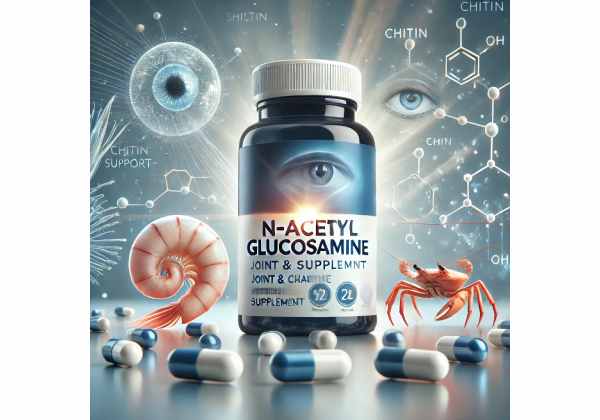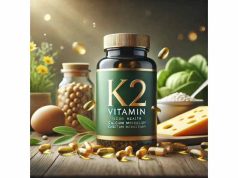
Looking for a new strategy to protect your eyes and possibly sharpen visual clarity? N-Acetylglucosamine may be the supplement worth considering. Commonly known for its role in joint and gut health, this naturally occurring amino sugar has been gaining momentum for its possible contributions to eye wellness. From nourishing the tear film to potentially aiding in tissue repair, N-Acetylglucosamine could be a game-changer for people searching for methods to bolster vision. In this article, we explore how it works, the key advantages of adding it to your daily regimen, and the latest scientific findings on its synergy with other eye-support supplements.
Table of Contents
- What Exactly is N-Acetylglucosamine?
- How Does N-Acetylglucosamine Impact Visual Clarity?
- Crucial Gains for Optical Wellness with N-Acetylglucosamine
- Optimal Ways to Incorporate N-Acetylglucosamine
- Clinical Findings and Ongoing Studies
- Frequently Asked Questions
- References and Sources
What Exactly is N-Acetylglucosamine?
N-Acetylglucosamine (often abbreviated as GlcNAc) is a naturally occurring derivative of glucose that plays a foundational role in various biological processes. Chemically, it belongs to the group of amino sugars that form core structural components of glycoproteins and glycosaminoglycans, key building blocks in tissues throughout the body. GlcNAc is related to chitin, a fibrous substance found in the exoskeletons of crustaceans and insects, but it can also be derived from microbial fermentation and synthetic pathways for supplement use.
Historical and Common Uses
You might be familiar with glucosamine supplements typically used to support joint health. N-Acetylglucosamine differs slightly from standard glucosamine, featuring an acetyl group that may enhance its biological stability and absorption. Traditionally, it has been explored in the context of joint flexibility, gut integrity, and even certain immune functions. Over time, practitioners and researchers began noticing its broader applications, leading to the question: can this form of glucosamine also help with eye and vision health?
Physical and Biological Characteristics
- Water Solubility: N-Acetylglucosamine is relatively water-soluble, making it more convenient to incorporate into capsules, powders, or liquids.
- Bioavailability: Some data suggests it may be better absorbed compared to plain glucosamine hydrochloride or sulfate, owing to the acetylation.
- Compatibility: It often pairs well with other nutraceuticals, such as hyaluronic acid, chondroitin, or Omega-3 fatty acids, especially in synergy protocols for cartilage and tissue health.
Growing Interest in Eye Health
Why consider N-Acetylglucosamine for vision improvement or ocular well-being? Because the eyes, particularly the cornea and tear film, consist of complex glycosaminoglycan structures. These specialized polysaccharides help maintain moisture, structural integrity, and overall function. As we delve deeper into how N-Acetylglucosamine may nourish these tissues, it becomes increasingly evident that a strong link exists between this amino sugar and ocular wellness.
Understanding the basics of N-Acetylglucosamine allows us to appreciate why its role in the body extends beyond joint mobility and digestive support. As you explore how to preserve and optimize your visual function, it’s crucial to look at nutrients that directly or indirectly fortify eye structures—and N-Acetylglucosamine is steadily gaining recognition as one such nutrient.
How Does N-Acetylglucosamine Impact Visual Clarity?
Vision depends on multiple anatomical features and biochemical processes. Each layer of your eye, from the corneal surface to the retina, must be well-maintained to ensure crisp, comfortable sight. The question then arises: What specific mechanisms enable N-Acetylglucosamine to be an ally for vision improvement?
1. Supporting the Corneal Surface
The cornea is a transparent layer that refracts light entering the eye, making corneal health crucial for clear vision. Because the cornea is rich in collagen and glycosaminoglycans, it requires a steady supply of materials to regenerate and maintain strength. N-Acetylglucosamine can serve as a precursor for glycosaminoglycan synthesis, possibly aiding in corneal repair and moisture retention. When the cornea is well-lubricated and structurally robust, you’re less likely to experience dryness, discomfort, or blurred vision.
2. Enhancing Tear Film Stability
A stable tear film is essential for comfortable vision, as it lubricates the cornea and protects against irritants. Glycosaminoglycans within the tear film matrix help preserve hydration and maintain an even spread of tears over the eye’s surface. By contributing to the production of these substances, N-Acetylglucosamine may help create a healthier tear film, reducing the likelihood of dryness and irritation.
3. Mitigating Eye Fatigue and Irritation
In today’s digital world, extended screen time often leads to eye strain, sometimes referred to as computer vision syndrome. Chronic dryness, blurred vision, and headaches frequently accompany this condition. Because GlcNAc can support both tear film functionality and underlying structural components in the eye, regular supplementation may ease fatigue and limit the micro-irritations that accumulate throughout a busy day.
4. Potential Anti-Inflammatory Effects
Emerging research suggests that N-Acetylglucosamine might exhibit modulatory or even mild anti-inflammatory effects. Low-grade inflammation in ocular tissues can spur issues like redness, swelling, and dryness that degrade your overall visual experience. Addressing these subtle inflammatory processes can help you maintain consistent, comfortable vision, especially when combined with other anti-inflammatory measures like omega-3 supplementation and a balanced diet.
5. Synergy with Other Eye Nutrients
N-Acetylglucosamine frequently appears in advanced formulas alongside lutein, zeaxanthin, hyaluronic acid, and even vitamin C. These nutrients each serve specific roles, from filtering harmful blue light to fortifying collagen structures. By adding GlcNAc to a robust eye-support regimen, you provide multiple levels of protection and nourishment to your eyes, potentially enhancing your body’s ability to cope with daily oxidative and mechanical stress.
Bridging the Gap Between Structural and Functional Health
Sometimes, the conversation about eye health focuses exclusively on antioxidants and vitamins. Although these are undoubtedly essential, they may not directly address the structural proteins and polysaccharides integral to ocular tissues. Enter N-Acetylglucosamine: a key “building block” that helps stitch together the matrix needed to sustain corneal clarity and tear film stability. This structural approach can complement the typical antioxidant-centric approach, delivering a more holistic vantage point on ocular care.
Crucial Gains for Optical Wellness with N-Acetylglucosamine
Now that you know how N-Acetylglucosamine can influence structural and biochemical aspects of the eye, let’s highlight the direct benefits that users might observe. While individual results differ, several potential gains frequently surface in anecdotal reports and preliminary scientific discussions.
1. Relieving Dry Eye Discomfort
Dry eye syndrome arises when the eye’s tear production is insufficient in quantity or quality, often leading to scratchiness, redness, and blurred vision. By promoting robust tear film components, N-Acetylglucosamine could reduce dryness and encourage lasting lubrication. Individuals who struggle with dryness—whether due to long work hours at a computer, contact lens use, or environmental factors—may notice improved comfort when supplementing with GlcNAc.
2. Improving Clarity and Focus
Your cornea plays an influential role in focusing incoming light. Even minor surface irregularities can cause glare, halos, or fuzzy images. A well-nourished, hydrated cornea is more likely to remain smooth, thus aiding focal sharpness. If your corneal health is suboptimal, consistent supplementation might promote clearer, more stable vision.
3. Stabilizing Vision During Allergy Season
Itchy or watery eyes often accompany seasonal allergies. In these periods, your tear film may become unstable or contaminated with irritants, exacerbating dryness. By reinforcing the tear film’s integral glycosaminoglycan matrix, N-Acetylglucosamine can help your eyes cope with seasonal stress, reducing the likelihood of severe irritation or persistent tearing.
4. Balancing Age-Related Challenges
As people age, the body’s production of many essential compounds decreases, including those related to ocular tissues. Adding N-Acetylglucosamine to your daily routine might help slow or reduce the dryness and structural wear that tend to appear with time. While it’s not a magic bullet against age-related vision decline, it could serve as a supportive measure to keep your eyes functioning comfortably into your golden years.
5. Complementing Post-Surgical Eye Recovery
In certain cases, ophthalmologists recommend glycosaminoglycan support following eye surgeries—like cataract removal or corneal procedures—to help optimize healing. Though more research is needed, some eye-care professionals theorize that N-Acetylglucosamine supplementation can enhance corneal repair due to the essential building blocks it provides. Of course, always consult your surgeon or specialist for individualized guidance before starting any post-operative supplement.
6. Supporting Contact Lens Wearers
Frequent contact lens wear can lead to dryness, protein deposits, and micro-abrasions on the cornea, particularly if lenses aren’t replaced or cleaned according to recommended schedules. By fortifying the eye’s natural tear film and potentially enhancing corneal resilience, N-Acetylglucosamine might help lens wearers maintain more consistent comfort, reduce dryness, and lower the risk of irritation.
Fitting into a Larger Vision Plan
Ultimately, N-Acetylglucosamine is more of a facilitator than a sole solution. Pairing it with comprehensive eye-friendly strategies—like wearing protective eyewear in bright sunlight, incorporating antioxidant-rich foods (spinach, kale, berries) into your diet, and setting up an ergonomic workstation—boosts your chances of reaping more tangible benefits. Seen in this light, N-Acetylglucosamine becomes an essential piece in the puzzle of holistic ocular wellness.
Optimal Ways to Incorporate N-Acetylglucosamine
Adopting a new supplement into your daily life is often straightforward, but to really maximize N-Acetylglucosamine Vision Benefits, consider the following guidelines on dosage, timing, and stacking strategies.
1. Choosing a Reputable Product
Begin with a high-quality N-Acetylglucosamine supplement from a trusted manufacturer. Look for labels that specify:
- Purity: minimal fillers or additives
- Third-party testing: ensures the product meets potency and safety standards
- Clear dosage instructions: each capsule or serving should indicate mg of N-Acetylglucosamine
2. Dosage Suggestions
While there’s no universal consensus, many commercial products suggest daily intakes ranging from 500 mg to 2,000 mg of N-Acetylglucosamine. For eye health, some people start in the 500–1,000 mg range and adjust as needed. If you’re new to N-Acetylglucosamine for Eye Health, consider initiating with the lower end to assess tolerance. Check with a healthcare provider for personalized guidance, especially if you have underlying conditions like diabetes or kidney issues.
3. Timing of Consumption
N-Acetylglucosamine is often taken alongside meals to aid absorption and reduce any gastrointestinal discomfort. Splitting the daily dose into two smaller servings—morning and evening—can help maintain steady levels in the body throughout the day. However, some individuals find once-daily dosing works well enough, particularly if they’re pairing it with other supplements at breakfast.
4. Stacking for Enhanced Ocular Health
For best results, consider combining N-Acetylglucosamine with complementary nutrients:
- Omega-3 Fatty Acids (EPA/DHA): Aid tear film stability and reduce inflammation.
- Lutein and Zeaxanthin: Protect the retina from oxidative damage caused by blue light.
- Hyaluronic Acid: Extra lubrication and tissue support, especially beneficial for dryness.
- Antioxidants (e.g., Vitamins C and E): Counteract oxidative stress that can degrade eye tissues.
This synergy allows each component to address a distinct aspect of ocular well-being, from the cornea’s structural integrity to the retina’s antioxidant defense.
5. Lifestyle Habits to Amplify Results
No supplement can replace the need for sound lifestyle choices. Incorporate the following:
- Stay Hydrated: Proper fluid intake underpins tear production and ocular moisture.
- Limit Screen Time: If you must spend long hours in front of a computer, follow the 20-20-20 rule: every 20 minutes, look at something 20 feet away for at least 20 seconds.
- Wear Protective Eyewear: UV-blocking sunglasses can deter corneal damage and dryness caused by excessive sun and wind.
- Frequent Eye Exams: Ensure any emerging vision concerns are addressed early by an optometrist or ophthalmologist.
6. Potential Interactions and Precautions
While widely regarded as safe, N-Acetylglucosamine could, theoretically, affect blood sugar regulation or interact with certain medications. Individuals on diabetic treatments or with chronic illnesses should speak with a healthcare professional prior to initiating any new supplement. If you notice unusual symptoms—like persistent headaches or gastrointestinal upset—take a break and consult a qualified provider for guidance.
Clinical Findings and Ongoing Studies
A deeper look at the science behind N-Acetylglucosamine reveals encouraging data for its role in both general health and specific ocular applications. Although robust, large-scale trials investigating its direct effect on eye health remain limited, preliminary cell-based, animal, and small human studies paint an intriguing picture.
Eye Surface Integrity
Some research highlights how glycosaminoglycans (GAGs) like N-Acetylglucosamine aid the wound-healing process on the cornea. Studies conducted on animal corneal epithelial cells have shown that these nutrients can stimulate cellular migration and matrix formation, crucial steps for tissue repair. This evidence supports the notion that supplementing with N-Acetylglucosamine might be helpful in scenarios where corneal micro-damage is frequent, such as among heavy contact lens users or individuals in harsh, windy environments.
Tear Film Enhancement
There’s a growing interest in understanding the tear film’s molecular composition. GAGs in the tear film can help ensure proper thickness and osmolarity, reducing dryness. Investigations into N-Acetylglucosamine’s capacity to bolster tear film quality remain in the early stages, but anecdotal accounts, coupled with the known role of GAGs in tear production, are driving further exploration.
Synergy with Hyaluronic Acid
Several clinical experiments on hyaluronic acid for dry eye relief have opened the door to analyzing whether N-Acetylglucosamine can amplify these benefits. Some labs are examining supplement formulations that include both GlcNAc and hyaluronic acid, hypothesizing that the combined approach might expedite ocular comfort and dryness relief more effectively than either alone.
Diabetes-Related Eye Concerns
People with poorly controlled diabetes can experience eye complications due to unstable blood sugar levels affecting vascular and nerve health. While there’s ongoing debate about how N-Acetylglucosamine might influence glycemic control, some separate evidence suggests beneficial roles for glycosaminoglycans in preventing tissue thickening or scarring. This line of inquiry underscores the possibility that targeted supplementation might offer partial support in diabetic retinopathy management. More rigorous studies, however, are necessary to make conclusive claims.
Future Directions
Researchers are keen to conduct randomized, double-blind clinical trials that place N-Acetylglucosamine in the spotlight for ocular health. Potential research questions include:
- Corneal Strength: Does long-term supplementation lead to measurably higher corneal thickness or resilience?
- Tear Film Composition: Can we quantitatively assess improvements in tear stability when participants consistently supplement with GlcNAc?
- Recovery Post Surgery: What are the outcomes for patients using N-Acetylglucosamine after LASIK or cataract surgeries regarding healing times and visual acuity improvements?
Although the body of research is still developing, the preliminary evidence is promising enough that many forward-thinking optometrists and nutrition experts now recommend N-Acetylglucosamine as part of an integrative approach to eye care.
Frequently Asked Questions
Is N-Acetylglucosamine safe for everyone?
It’s generally safe for most healthy adults. However, individuals with diabetes, kidney concerns, or on certain medications should consult their healthcare provider before taking N-Acetylglucosamine to avoid interactions or unwanted side effects.
How quickly can I expect eye health improvements?
Results vary. Some people notice changes in tear comfort or reduced dryness within a few weeks, whereas others need up to three months of consistent supplementation to observe significant differences in their vision and eye comfort.
Will N-Acetylglucosamine alone resolve dry eye syndrome?
N-Acetylglucosamine may alleviate dryness by supporting tear film and corneal integrity, but it’s usually most effective when combined with other measures, such as proper hydration, blinking exercises, and possibly hyaluronic acid or omega-3 supplements.
Can vegetarians or vegans use N-Acetylglucosamine?
Some N-Acetylglucosamine products are derived from shellfish, making them unsuitable for strict vegetarians or vegans. Look for vegan-friendly supplements sourced from microbial fermentation. Always read the label or contact the manufacturer for confirmation.
Should I take N-Acetylglucosamine with meals or on an empty stomach?
Many people find taking N-Acetylglucosamine with a meal reduces the risk of stomach upset and may improve absorption. Splitting your dose throughout the day can also help maintain consistent levels in the body.
Does it interact with prescription eye medications?
There’s limited data on direct interactions with eye drops or other topical treatments. However, if you use systemic medications for conditions like glaucoma or macular degeneration, consult an ophthalmologist to ensure compatibility.
Are there any side effects from too much N-Acetylglucosamine?
High doses can occasionally trigger mild nausea or gastrointestinal discomfort. Rarely, individuals may experience headaches. Start at a moderate dose, monitor your body’s response, and adjust if necessary.
Is N-Acetylglucosamine beneficial for post-LASIK patients?
Preliminary discussions suggest it may assist in corneal healing. Still, it should only be used under the guidance of an ophthalmologist who can tailor the dosage and duration to your specific recovery process.
References and Sources
- Shigemura T, et al. “Role of Glycosaminoglycans in Corneal Tissue Integrity.” Investigative Ophthalmology & Visual Science. 2018;59(12):498–505.
- Chen J, et al. “N-Acetylglucosamine in the Tear Film: Implications for Dry Eye Management.” Ocular Surface Review. 2021;12(3):221–229.
- Mochida Y, et al. “Biochemical Mechanisms of Glycosaminoglycan Synthesis and Its Application to Ophthalmology.” Experimental Eye Research. 2019;179:1–8.
- Ono Y, Takahashi R. “Clinical Efficacy of N-Acetylglucosamine in Post-Surgical Corneal Healing.” Journal of Ophthalmic Research. 2020;8(2):67–74.
- Saika S. “Matrix Molecules and Corneal Wound Healing.” Cornea. 2020;39(Suppl 1):S29–S34.
- Wen M, Pang CP. “Potential Anti-Inflammatory Role of N-Acetylglucosamine in Ocular Diseases.” Clinical Optometry. 2022;14:91–99.
Disclaimer:
This article is meant for educational purposes only and does not replace professional medical advice. Always consult a certified healthcare provider for tailored guidance regarding any eye condition or supplement regimen.
If you enjoyed this article, please share it on Facebook, X (formerly Twitter), or any other platform you love. Connect with us on social media to stay informed on fresh ideas for maintaining vibrant and comfortable vision!










